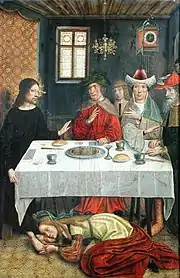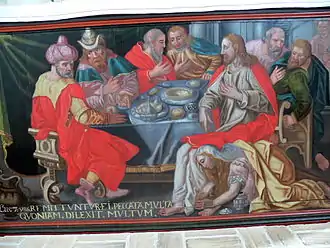| Luke 7 | |
|---|---|
_Luc_7%252C36.37.jpg.webp) Luke 7:36,37 on Papyrus 3, written about 6th/7th century. | |
| Book | Gospel of Luke |
| Category | Gospel |
| Christian Bible part | New Testament |
| Order in the Christian part | 3 |
Luke 7 is the seventh chapter of the Gospel of Luke in the New Testament of the Christian Bible. It tells the records of two great miracles performed by Jesus, his reply to John the Baptist's question, and the anointing by a sinful woman.[1] The book containing this chapter is anonymous, but early Christian tradition uniformly affirmed that Luke the Evangelist, a companion of Paul the Apostle on his missionary journeys,[2] composed this Gospel as well as the Acts of the Apostles.[3]
Text

The original text was written in Koine Greek. This chapter is divided into 50 verses.
Textual witnesses
Some early manuscripts containing the text of this chapter are:
- Papyrus 75 (AD 175-225)
- Papyrus 45 (~250).
- Codex Vaticanus (325-350)
- Codex Sinaiticus (330-360)
- Codex Bezae (~400)
- Codex Washingtonianus (~400)
- Codex Ephraemi Rescriptus (~450; lacunae: verse 17 to end)
- Papyrus 2 (~550; extant verses 22-26 and 50 in Coptic language)[4]
- Papyrus 3 (6th/7th century; extant verses 36-45)[4]
Healing the centurion's servant (7:1-10)
Luke 7:1-10 relates that, when Jesus had "concluded all his sayings", a Roman centurion in Capernaum sent the Jewish elders to ask Jesus for help, because his servant (or slave) was ill.[5] The elders testified to the centurion's worthiness (ἄξιός, axios) but the centurion did not consider himself worthy (using the same Greek word, ηξιωσα, ēxiōsa)[6] to have Jesus come into his home to perform the healing, suggesting instead that Jesus perform the healing at a distance. Jesus concurred, and the servant was found to have been healed when the centurion returned home.
Matthew 8:5–13 records the same healing. A similar event is recounted in John 4:46–53, but this may refer to another event as it concerns the son of a court official.
Widow of Nain's son raised (7:11-17)

This account of a miracle by Jesus is only recorded in the Gospel of Luke.[7] Jesus, accompanied by a large crowd (verse 11), arrived at the gates of the village of Nain during the burial ceremony of the son of a widow, and raised the young man from the dead. The location is the village of Nain in Galilee, two miles south of Mount Tabor. This is the first of three miracles of Jesus in the canonical gospels in which he raises the dead, the other two being the raising of Jairus' daughter and of Lazarus.
Following the healing, Jesus' fame spread "throughout all Judea and all the surrounding region".[8] In the Cambridge Bible for Schools and Colleges, commentator F. W. Farrar explains that "the notion that St Luke therefore supposed Nain to be in Judaea is quite groundless. He means that the story of the incident at Nain spread even into Judaea".[9]
Some parallels in details are noted with the raising of the son of the widow of Zarephath, by the Old Testament prophet Elijah (1 Kings 17),[10] especially some verbal parallels.[11] The raising of the son of the woman of Shunem (2 Kings 4) by Elisha is also similar, including the reaction of the people, and in particular, the location of Nain is very close to Shunem (identified with modern Sulam), giving an example of a repeated pattern in the history of redemption.[12]
Messengers from John the Baptist (7:18-35)

When John the Baptist was in prison and heard of the works performed by Jesus, John sent two of his disciples as messengers to ask a question of Jesus:
- "Are you the one who is to come (ὁ ἐρχόμενος, ho erchomenos), or should we expect someone else?"[13]
Following this episode, Jesus begins to speak to the crowds about John the Baptist, describing him as the 'messenger', a prophet who was himself foretold in prophecy (Malachi 3:1).[14]
Parable of the Two Debtors (7:36-50)
_-_interior%252C_stained_glass%252C_A_Disciple_washes_Christ%E2%80%99s_feet.jpg.webp)

A Pharisee named Simon invites Jesus to eat in his house but fails to show him the usual marks of hospitality offered to visitors - a greeting kiss (v. 45), water to wash his feet (v. 44), or oil for his head (v. 46). A "sinful woman" comes into his house during the meal and anoints Jesus' feet with perfume, wiping them dry with her hair. Simon is inwardly critical of Jesus, who, if he were a prophet, "would know what kind of sinful life she lives".[15]
Jesus then uses the story of two debtors to explain that a woman loves him more than his host, because she has been forgiven of greater sins.
Verse 38
- And stood at his feet behind him weeping, and began to wash his feet with tears, and did wipe them with the hairs of her head, and kissed his feet, and anointed them with the ointment.[16]
- "Stood at his feet behind him": Jesus, as other guests, 'reclined on couches with their feet turned outwards', a common posture in that period of time also for Persians, Greeks, Romans.[17] This arrangement is called triclinia, by which the guest reposed on his elbow at the table, with his unsandaled feet outstretched on the couch (as each guest left the sandals beside the door on entering).[9]
- "Ointment": or "fragrant oil" in NKJV, is translated from the Greek word μύρον which was applied 'for any kind of sweet-smelling vegetable essence, especially that of the myrtle'.[18]
Verses 47-48
- "Therefore I tell you, her sins, which are many, are forgiven, for she loved much; but he who is forgiven little, loves little.” 48 And he said to her, “Your sins are forgiven.”[19]
Eric Franklin observes that the woman is demonstrating her love and asks whether this is "because she has already been forgiven, which is what the parable would imply?" Verse 47, "on a first reading at any rate, does not appear to support this, but rather suggests that she has been forgiven because of her love". The Revised Standard Version and the New King James Version can be read in this way. Franklin notes that "more recent translations, assuming a consistency in the story as a whole, take the Greek ὅτι (hoti, translated as "for" in the quoted passage above) to mean, not "because" but "with the result that", for example the Revised English Bible translates, "Her great love proves that her many sins have been forgiven". Verse 48 then proclaims her forgiveness, which this translation assumes has already been pronounced to her.[20]
See also
- Dead Sea Scrolls 4Q521
- Miracles of Jesus
- Nain, Israel
- Other related Bible parts: Matthew 8, Matthew 11, John 4
References
- ↑ Halley, Henry H., Halley's Bible Handbook: an Abbreviated Bible Commentary. 23rd edition. Zondervan Publishing House. 1962.
- ↑ Jerusalem Bible (1966), "Introduction to the Synoptic Gospels", New Testament p. 5
- ↑ Holman Illustrated Bible Handbook. Holman Bible Publishers, Nashville, Tennessee. 2012.
- 1 2 Aland, Kurt; Aland, Barbara (1995). The Text of the New Testament: An Introduction to the Critical Editions and to the Theory and Practice of Modern Textual Criticism. Erroll F. Rhodes (trans.). Grand Rapids: William B. Eerdmans Publishing Company. p. 96. ISBN 978-0-8028-4098-1.
- ↑ Translated as 'slave' in the RSV and the Holman Christian Standard Bible
- ↑ Strong's Concordance: 515 axioó: to deem worthy
- ↑ Meyer, H. A. W. (1880), Meyer's NT Commentary on Luke 7, translated from the German sixth edition, accessed 31 December 2021
- ↑ Luke 7:17
- 1 2 Farrar, F. W. (1891), Cambridge Bible for Schools and Colleges on Luke 7, accessed 6 June 2018
- ↑ Fred Craddock, Luke, 2009 ISBN 0664234356 page 43, 95–8
- ↑ The People's New Testament Commentary - M. Eugene Boring, Fred B. Craddock - 2004 Page 204 "7:11-17 RAISING THE WIDOW'S SON This story is only in Luke, but it has many points of contact with the story of Elijah's raising the widow of Zarephath's son (1 Kgs. 17:8-24), including such verbatim parallels as "he gave him to his mother" ..."
- ↑ Sinclair Ferguson, Preaching Christ from the Old Testament Archived 2013-09-03 at the Wayback Machine, Proclamation Trust, 2002, page 12.
- ↑ Luke 7:19: New International Version, repeated in 7:20
- ↑ Guzik, D., Enduring Word Bible Commentary: Luke 7 - The Sick Healed, the Dead Raised, the Sinner Forgiven, accessed 1 January 2022
- ↑ Luke 7:39: Good News Translation
- ↑ Luke 7:38 KJV
- ↑ Expositor's Greek Testament. Luke 7. Accessed 24 April 2019.
- ↑ Exell, Joseph S.; Spence-Jones, Henry Donald Maurice (Editors). On "Luke 7" in The Pulpit Commentary. 23 volumes. First publication: 1890. Accessed 24 April 2019.
- ↑ Luke 7:47–48: Revised Standard Version
- ↑ Franklin, E., 59. Luke in Barton, J. and Muddiman, J. (2001), The Oxford Bible Commentary, p. 936
External links
- Luke 7 King James Bible - Wikisource
- English Translation with Parallel Latin Vulgate
- Online Bible at GospelHall.org (ESV, KJV, Darby, American Standard Version, Bible in Basic English)
- Multiple bible versions at Bible Gateway (NKJV, NIV, NRSV etc.)
| Preceded by Luke 6 |
Chapters of the Bible Gospel of Luke |
Succeeded by Luke 8 |